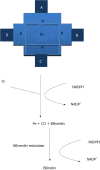Cytoprotective role of heme oxygenase-1 and heme degradation derived end products in liver injury
- PMID: 24179613
- PMCID: PMC3812456
- DOI: 10.4254/wjh.v5.i10.541
Cytoprotective role of heme oxygenase-1 and heme degradation derived end products in liver injury
Abstract
The activation of heme oxygenase-1 (HO-1) appears to be an endogenous defensive mechanism used by cells to reduce inflammation and tissue damage in a number of injury models. HO-1, a stress-responsive enzyme that catabolizes heme into carbon monoxide (CO), biliverdin and iron, has previously been shown to protect grafts from ischemia/reperfusion and rejection. In addition, the products of the HO-catalyzed reaction, particularly CO and biliverdin/bilirubin, have been shown to exert protective effects in the liver against a number of stimuli, as in chronic hepatitis C and in transplanted liver grafts. Furthermore, the induction of HO-1 expression can protect the liver against damage caused by a number of chemical compounds. More specifically, the CO derived from HO-1-mediated heme catabolism has been shown to be involved in the regulation of inflammation; furthermore, administration of low concentrations of exogenous CO has a protective effect against inflammation. Both murine and human HO-1 deficiencies have systemic manifestations associated with iron metabolism, such as hepatic overload (with signs of a chronic hepatitis) and iron deficiency anemia (with paradoxical increased levels of ferritin). Hypoxia induces HO-1 expression in multiple rodent, bovine and monkey cell lines, but interestingly, hypoxia represses expression of the human HO-1 gene in a variety of human cell types (endothelial cells, epithelial cells, T cells). These data suggest that HO-1 and CO are promising novel therapeutic molecules for patients with inflammatory diseases. In this review, we present what is currently known regarding the role of HO-1 in liver injuries and in particular, we focus on the implications of targeted induction of HO-1 as a potential therapeutic strategy to protect the liver against chemically induced injury.
Keywords: Bilirubin; Heme oxygenases; Hepatitis C; Hypoxia; Immunoregulatory; Kupffer cells; Liver ischemia; Polymorphisms.
Figures


Similar articles
-
Heme oxygenase-1 and its reaction product, carbon monoxide, prevent inflammation-related apoptotic liver damage in mice.Hepatology. 2003 Oct;38(4):909-18. doi: 10.1053/jhep.2003.50386. Hepatology. 2003. PMID: 14512878
-
Cytoprotective role of heme oxygenase-1 in liver ischemia reperfusion injury.Int J Clin Exp Med. 2015 Nov 15;8(11):19867-73. eCollection 2015. Int J Clin Exp Med. 2015. PMID: 26884897 Free PMC article. Review.
-
Heme oxygenase-1: a novel therapeutic target for gastrointestinal diseases.J Clin Biochem Nutr. 2011 Mar;48(2):126-33. doi: 10.3164/jcbn.10-61. Epub 2011 Feb 26. J Clin Biochem Nutr. 2011. PMID: 21373265 Free PMC article.
-
Therapeutic Potential of Heme Oxygenase-1/carbon Monoxide System Against Ischemia-Reperfusion Injury.Curr Pharm Des. 2017;23(26):3884-3898. doi: 10.2174/1381612823666170413122439. Curr Pharm Des. 2017. PMID: 28412905 Review.
-
Heme Oxygenase-1: An Anti-Inflammatory Effector in Cardiovascular, Lung, and Related Metabolic Disorders.Antioxidants (Basel). 2022 Mar 15;11(3):555. doi: 10.3390/antiox11030555. Antioxidants (Basel). 2022. PMID: 35326205 Free PMC article. Review.
Cited by
-
Impact of chronic and acute inflammation on extra- and intracellular iron homeostasis.Am J Clin Nutr. 2017 Dec;106(Suppl 6):1581S-1587S. doi: 10.3945/ajcn.117.155838. Epub 2017 Oct 25. Am J Clin Nutr. 2017. PMID: 29070546 Free PMC article. Review.
-
Carbon Monoxide (CO) Released from Tricarbonyldichlororuthenium (II) Dimer (CORM-2) in Gastroprotection against Experimental Ethanol-Induced Gastric Damage.PLoS One. 2015 Oct 13;10(10):e0140493. doi: 10.1371/journal.pone.0140493. eCollection 2015. PLoS One. 2015. PMID: 26460608 Free PMC article.
-
Antioxidant and anti-inflammatory agents in chronic liver diseases: Molecular mechanisms and therapy.World J Hepatol. 2023 Feb 27;15(2):180-200. doi: 10.4254/wjh.v15.i2.180. World J Hepatol. 2023. PMID: 36926234 Free PMC article. Review.
-
Omega-3 fatty acids decrease oxidative stress and inflammation in macrophages from patients with small abdominal aortic aneurysm.Sci Rep. 2019 Sep 10;9(1):12978. doi: 10.1038/s41598-019-49362-z. Sci Rep. 2019. PMID: 31506475 Free PMC article.
-
Casein Glycomacropeptide Hydrolysates Exert Cytoprotective Effect against Cellular Oxidative Stress by Up-Regulating HO-1 Expression in HepG2 Cells.Nutrients. 2017 Jan 15;9(1):31. doi: 10.3390/nu9010031. Nutrients. 2017. PMID: 28098837 Free PMC article.
References
-
- Habtezion A, Kwan R, Yang AL, Morgan ME, Akhtar E, Wanaski SP, Collins SD, Butcher EC, Kamal A, Omary MB. Heme oxygenase-1 is induced in peripheral blood mononuclear cells of patients with acute pancreatitis: a potential therapeutic target. Am J Physiol Gastrointest Liver Physiol. 2011;300:G12–G20. - PMC - PubMed
-
- Abdureyim S, Amat N, Umar A, Upur H, Berke B, Moore N. Anti-inflammatory, immunomodulatory, and heme oxygenase-1 inhibitory activities of ravan napas, a formulation of uighur traditional medicine, in a rat model of allergic asthma. Evid Based Complement Alternat Med. 2011;2011:pii: 725926. - PMC - PubMed
-
- Ozawa E, Abiru S, Nagaoka S, Yano K, Komori A, Migita K, Yatsuhashi H, Taura N, Ichikawa T, Ishibashi H, et al. Ferritin/alanine aminotransferase ratio as a possible marker for predicting the prognosis of acute liver injury. J Gastroenterol Hepatol. 2011;26:1326–1332. - PubMed
-
- Immenschuh S, Baumgart-Vogt E, Mueller S. Heme oxygenase-1 and iron in liver inflammation: a complex alliance. Curr Drug Targets. 2010;11:1541–1550. - PubMed
-
- Brockmann JG, August C, Wolters HH, Homme R, Palmes D, Baba H, Spiegel HU, Dietl KH. Sequence of reperfusion influences ischemia/reperfusion injury and primary graft function following porcine liver transplantation. Liver Transpl. 2005;11:1214–1222. - PubMed
Publication types
LinkOut - more resources
Full Text Sources
Other Literature Sources

